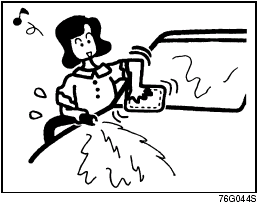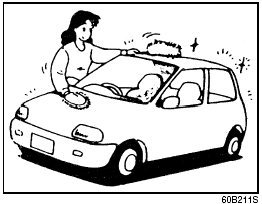 Suzuki Grand Vitara: Vehicle Cleaning
Suzuki Grand Vitara: Vehicle Cleaning

 WARNING: When cleaning the interior
or exterior of the vehicle, NEVER USE flammable solvents such lacquer thinners,
gasoline, benzene or cleaning materials such as bleaches and strong household detergents.
The materials could cause personal injury or damage to the vehicle.
WARNING: When cleaning the interior
or exterior of the vehicle, NEVER USE flammable solvents such lacquer thinners,
gasoline, benzene or cleaning materials such as bleaches and strong household detergents.
The materials could cause personal injury or damage to the vehicle.
Cleaning Interior
Vinyl upholstery
Prepare a solution of soap or mild detergent mixed with warm water. Apply the solution to the vinyl with a sponge or soft cloth and let it soak for a few minutes to loosen dirt. Rub the surface with a clean, damp cloth to remove dirt and the soap solution. If some dirt still remains on the surface, repeat this procedure.
Fabric upholstery
Remove loose dirt with a vacuum cleaner. Using a mild soap solution, rub stained areas with a clean damp cloth. To remove soap, rub the areas again with a cloth dampened with water. Repeat this until the stain is removed, or use a commercial fabric cleaner for tougher stains. If you use a fabric cleaner, carefully follow the manufacturer’s instructions and precautions.
Leather upholstery
Remove loose dirt with a vacuum cleaner. Using a mild soap or saddle soap solution, wipe dirt off with a clean damp soft cloth. To remove soap, wipe the areas again with a soft cloth dampened with water. Wipe the areas dry with a soft dry cloth. Repeat this until the dirt or stain is removed, or use a commercial leather cleaner for tougher dirt or stains. If you use a leather cleaner, carefully follow the manufacture’s instructions and precautions. Do not use solvent type cleaners or abrasive cleaners.
Seat belts
Clean seat belts with a mild soap and water. Do not use bleach or dye on the belts. They may weaken the fabric in the belts.
Vinyl floor mats
Ordinary dirt can be removed from vinyl with water or mild soap. Use a brush to help loosen dirt. After dirt is loosened, rinse the mat thoroughly with water and dry it in the shade.
Carpets
Remove dirt and soil as much as possible with a vacuum cleaner. Using a mild soap solution, rub stained areas with a clean damp cloth. To remove soap, rub the areas again with a cloth dampened with water. Repeat this until the stain is removed, or use a commercial carpet cleaner for tougher stains. If you use a carpet cleaner, carefully follow the manufacturer’s instructions and precautions.
Instrument panel and console
NOTE: Wipe up spills containing chemicals, alcohol, etc., immediately with a soft, damp cloth. Use a mild soap solution if necessary. Do not use cleaners or polishes containing strong solvents or acidic solutions. These chemicals may stain and discolor the instrument panel and console.
Cleaning the Exterior
CAUTION: It is important that your vehicle be kept clean and free from dirt. Failure to keep your vehicle clean may result in fading of the paint or corrosion to various parts of the vehicle body.
Washing
 WARNING:
WARNING:
• Never attempt to wash and wax your vehicle with the engine running.
• When cleaning the underside of the body and fender, where there may be sharp-edged
parts, you should wear gloves and a long-sleeved shirt to protect your hands and
arms from being cut.
• After washing your vehicle, carefully test the brakes before driving to make sure
they have maintained their normal effectiveness.
When washing the vehicle, follow the instructions below: 1) Flush the underside of body and wheel housings with pressurized water to remove mud and debris. Use plenty of water.
CAUTION:
• When washing the vehicle, avoid directing steam or hot water of more than 80°C
(176°F) on plastic parts.
• To avoid damaging engine components, do not use pressurized water in the engine
compartment.
2) Rinse the body to loosen the dirt. Remove dirt and mud from the body exterior with running water. You may use a soft sponge or brush. Do not use hard materials which can scratch the paint or plastic. Remember that the headlight covers or lenses are made of plastic in many cases.
CAUTION: To avoid damage to the paint or plastic surface, do not wipe the dirt off without ample water. Be sure to follow above procedure.
3) Wash the entire exterior with a mild detergent or car wash soap using a sponge or soft cloth. The sponge or cloth should be frequently soaked in the soap solution.
CAUTION: When using a commercial car wash product, observe the cautions specified by the manufacturer. Never use strong household detergents or soaps.
4) Once the dirt has been completely removed, rinse off the detergent with running water. 5) After rinsing, wipe off the vehicle body with a wet chamois or cloth and allow it to dry in the shade. 6) Check carefully for damage to painted surfaces. If there is any damage, “touch-up” the damage following the procedure below: 1. Clean all damaged spots and allow them to dry. 2. Stir the paint and “touch-up” the damaged spots lightly using a small brush. 3. Allow the paint to dry completely.

Waxing
After washing the vehicle, waxing and polishing are recommended to further protect
and beautify the paint.
• Only use waxes and polishes of good quality.
• When using waxes and polishes, observe the precautions specified by the manufacturers.
 Corrosion Prevention
Corrosion Prevention
It is important to take good care of your vehicle to protect it from corrosion.
Listed below are instructions for how to maintain your vehicle to prevent corrosion.
Please read and follow these in ...
See also:
Towing your vehicle
When towing your vehicle, all State (Provincial in
Canada) and local regulations for towing must
be followed. Incorrect towing equipment could
damage your vehicle. Towing instructions are
avai ...
Changing the air cleaner filter
To change the filter, unsnap the clips around the
cover. When this is done, the cover can be lifted
off, the old filter removed and the new filter put
in its place. Genuine Hyundai Replacement ...
Mopar parts
MOPAR fluids, lubricants, parts, and accessories are
available from an authorized dealer. They are recommended
for your vehicle in order to help keep the vehicle
operating at its best. ...

